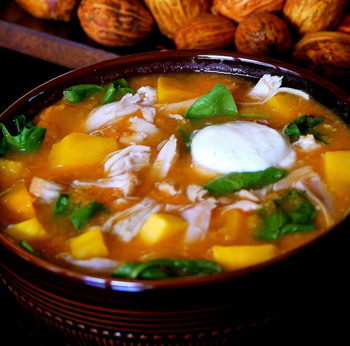From the Los Angeles Times
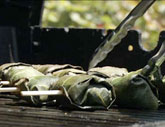 In the beautiful economy of the forest – or the urban backyard garden
– leaves are nature's brilliant cookware. Banana leaves can be cut
down to make plates or unfurled into wrappers perfect for steaming fish
on a low-slung grill. Fig trees and grapevines yield leaves the exact
size for enclosing, then grilling, a cube of feta, a recumbent sardine
or a mint-studded lamb meatball.
In the beautiful economy of the forest – or the urban backyard garden
– leaves are nature's brilliant cookware. Banana leaves can be cut
down to make plates or unfurled into wrappers perfect for steaming fish
on a low-slung grill. Fig trees and grapevines yield leaves the exact
size for enclosing, then grilling, a cube of feta, a recumbent sardine
or a mint-studded lamb meatball.
Before the invention of tinfoil or grilling baskets, pragmatic cooks
picked their kitchen supplies from branches and found what they needed
in the trees.
Going green was logical – OK, obvious – long before it became chic.

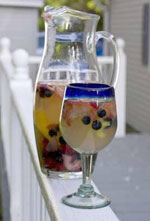 Traditional sangrias are luscious, bold blends of fruits, wine and spirits, often
served in pitchers or punch bowls. But this wonderfully refreshing
summer drink from Spain and Portugal leaves plenty of room for
improvisation.
Traditional sangrias are luscious, bold blends of fruits, wine and spirits, often
served in pitchers or punch bowls. But this wonderfully refreshing
summer drink from Spain and Portugal leaves plenty of room for
improvisation.
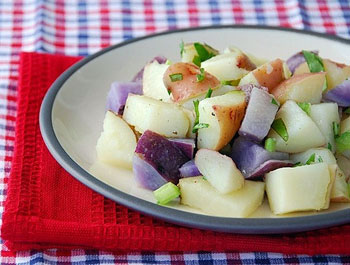 Generally I'm not one for "themed" food. But a girl's gotta have some fun. So for the 4th of July, I'd like to share a patriotic potato salad made with three kinds of spuds: old fashioned white russet, delicate red-skinned taters, and sassy All-Blue potatoes (which are sometimes labeled purple Peruvian).
Generally I'm not one for "themed" food. But a girl's gotta have some fun. So for the 4th of July, I'd like to share a patriotic potato salad made with three kinds of spuds: old fashioned white russet, delicate red-skinned taters, and sassy All-Blue potatoes (which are sometimes labeled purple Peruvian).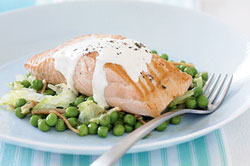 The “old timers” in Maine always eat salmon and peas for their fourth of July family feast. This tradition was started a long time ago when salmon still came “up river to spawn” and people still rushed in the Spring to plant their peas so they would have the first peas of the year, hopefully by the 4th, if the weather was good. (I still have customers that plant their peas in the fall so they sprout when they are ready come Spring.)
The “old timers” in Maine always eat salmon and peas for their fourth of July family feast. This tradition was started a long time ago when salmon still came “up river to spawn” and people still rushed in the Spring to plant their peas so they would have the first peas of the year, hopefully by the 4th, if the weather was good. (I still have customers that plant their peas in the fall so they sprout when they are ready come Spring.)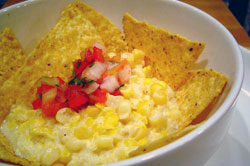 At my local farmers' market this past week, I found some thick, hefty ears of corn that had been growing all summer with swollen kernels to match. They reminded me of the juicy ears of corn we had used at Tante Marie's Cooking School in San Francisco when we made a wonderful corn soup with a fresh tomato salsa. As soon as I saw those ears of corn I knew I would make that soup as soon as I got home.
At my local farmers' market this past week, I found some thick, hefty ears of corn that had been growing all summer with swollen kernels to match. They reminded me of the juicy ears of corn we had used at Tante Marie's Cooking School in San Francisco when we made a wonderful corn soup with a fresh tomato salsa. As soon as I saw those ears of corn I knew I would make that soup as soon as I got home.